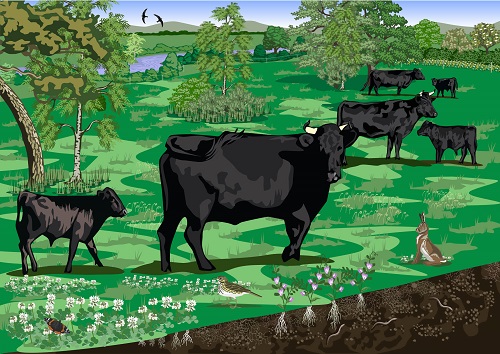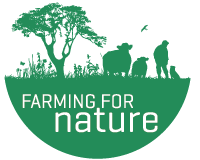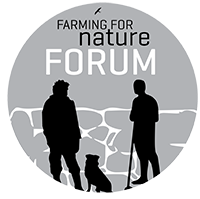BEEF
Here are some practical ways to take climate action and enhance biodiversity on your beef farm
Climate & Biodiversity actions full doc (pdf)
Beef section only (pdf)
Whilst every farm is different, every farm has something to offer to help mitigate climate change and help nature thrive, cleaner waters and improve soil biology on your land. The following are tips from other farmers compiled to help you find simple ways to improve upon these areas on your farm.
“Viewing the farm through basic ecological processes: water cycle, mineral cycle, energy flow, and community dynamics, is a fantastic way to shift your thinking towards farming with nature and low energy productivity. For example, increasing the number of green leaves photosynthesising on a given acre increases the amount of sunlight harnessed and therefore increases the “energy flow”. This will enhance the mineral cycle and improve soil structure, restoring the water cycle. The best way to maximise the number of green leaves is (through) “community dynamics” – (creating) denser swards with many different leaf shapes of different ages, filling different niches within the pasture. Above the pasture, there is potential for another canopy level with hedges and trees of different sizes and ages that will capture more sunlight, again increasing mineral cycles and improving the water cycle…..” Clive Bright, Beef farmer & FFN Ambassador, Co. Sligo
1. Nutrient management
Slurry and fertilisers release harmful greenhouse gases.
The manufacture of chemical fertilisers generates ~1.4% of all carbon dioxide emissions and the application of both slurry and fertilisers releases nitrous oxide, a gas with 300 times the global warming potential of carbon dioxide. A nutrient management plan can help you to reduce your use of these inputs (and their associated costs) by improving the efficiency of their use and absorption.
- Treat your slurry with respect! – slurry is an increasingly valuable farm asset, don’t waste it
- Retain, enhance and create buffer strips and hedgerows to help prevent nutrient run-off
- Maximise nutrient absorption by maintaining optimum soil pH
- Measure grass to identify fields that don’t need fertilising
- There is a slurry storage deficit on ~40% of Irish farms. Could a slight reduction in numbers take the pressure off in terms of slurry storage?
- Where possible, use low emissions slurry spreading
- To maximise nutrient absorption, spread fertiliser, slurry and farmyard manure on warmer days (soil temp at least 6°C) and don’t spread slurry out of season!
- Include nitrogen fixing legumes in swards or feed crops (e.g. clover, vetch, beans)
- Switch to using protected urea (rather than CAN)
- Try simple mobile phone operated GPSs and tractor sensors to maximise nutrient uptake through more targeted spreading
Co-benefits for farmers
- Decreased fertiliser use (lower costs)
- Increased farm self-sufficiency (lower external inputs)
- Decreased vulnerability to market forces (greater resilience)
“We have found that regenerative grazing practices have shown improvement in the soil and its fungal network in a just a couple of seasons. Furthermore by leaving branches, old logs and sticks laid into the base of a hedge (they) provide nesting cover for birds, protect saplings and rot down to feed soil. We take wood from coppiced or pollarded (coppiced above browse height to allow regrowth when stock have access) broadleaved trees as it is a long term sustainable source of fuel (firewood), fodder (stock love tree leaves) and bedding/mulch (woodchip)” Paul McCormick & Jacinta French, Beef & agroforestry farmers & FFN Ambassadors, Co. Cork.
2. Pastures & soil
Healthy soil stores carbon and maximises the grazing season.
Feeding (silage and concentrates) and housing livestock generates significantly higher emissions than keeping livestock at pasture. To maintain healthy soil and maximize the grazing season:
- Naturally fix nitrogen and improve drainage and drought tolerance by planting species-rich swards
- Allow sward diversity to develop naturally by reducing grassland management intensity (fertilising/spraying) and by avoiding overgrazing (especially in May-June when meadows are flowering)
- Keep your soil aerated by avoiding compaction by heavy machinery, poaching and pinch points
- Retain maximum soil carbon by minimising ploughing and reseeds
- Maximise the grazing season to minimise the need for imported feed – our use of soya based feeds is contributing to rapid destruction of the rainforest in Brazil
- Consider habitat adapted native or traditional breeds (e.g. Droimeann, Moiled, Kerry or Dexter cattle). These breeds are lighter on the land and require less intensive management to thrive
Co-benefits for farmers
- Reduced labour
- Reduced input costs
- Improved animal welfare
- Increased farm resilience and self-sufficiency
“We found the main key solution for nature restoration on our farm is habitat-adapted suckler cows. Using Galloway cows, we practice the following grazing hierarchy on the Omega Beef farm; precision, strategic, targeted and extensive grazing. Empirical evidence has shown that this type of grazing delivers not just for nature and soil restoration but also for climate and food security.” Joe Condon, Beef farmer & FFN Ambassador, Co. Tipperary
3. Water Management
Our water bodies (rivers, lakes and oceans) naturally work together to support biodiversity and to store carbon. When water bodies are polluted, these systems break down. Almost half of Irish surface waters are not in good health and the situation is deteriorating. Help to restore our water bodies by eliminating harmful farm run-off:
- Retain, enhance or create wetlands, buffer strips, field margins and native hedgerows to reduce run-off
- Never spread or spray inputs when rain is due
- Treat your chemicals with respect – just one drop of pesticide can pollute a small stream for over 30kms!!
- Reduce herbicide use by using alternative methods of weed control e.g. non-synthetic herbicides and diverse crop rotations. As many synthetic herbicides are water soluble (e.g. MCPA, 2,4-D), it is almost impossible to ensure they do not end up in watercourses after application
- List the potential sources of run-off from your farm and how you might eliminate them. Some of these (e.g. slurry, herbicides) are more obvious than others (e.g. spoil from tractor tyres, washings or waste silage).
- Manage grazing livestock: fence livestock well back from watercourses; don’t allow stock to drink directly from rivers; avoid poaching and pinch points
Co-benefits for farmers
- Reduced input, labour, fuel and machinery costs
- Cleaner water and improved health – research has detected herbicides in 38% of drinking water wells tested in Ireland!
4. Trees, scrub & hedgerows
Woody vegetation captures carbon.
- In less productive areas, allow for natural regeneration of trees and scrub
- Plant native hedgerows
- Allow existing hedgerows to grow tall and wide
- Experiment with agroforestry/ silvopasture to build a climate resilient farm system
- Diversify farm enterprises by planting a native woodland (or better yet, allow one to naturally regenerate!)
- Retain, enhance or create woodland areas, copses and scrubland
Co-benefits for farmers
In a beef farming system woody vegetation can:
- provide diverse grazing
- provide shade & shelter
- improve animal welfare
- enhance biodiversity
- diversify farm enterprises
“To date we have put in 17 ponds, planted 1000 trees/shrubs every year since 1958, planned grazing to encourage flowering pastures and have added homemade biochar to increase soil fertility and functionality. All of these actions have shown positive results” Kim & Mirielle McCall, Beef farmers and FFN Ambassadors, Co. Kildare
5. Energy & Fuel
Maximising energy efficiency and moving away from fossil fuels are two ways in which beef farmers can minimise their carbon footprint!
- Minimise the use of chemical fertilisers, herbicides and pesticides – these are all manufactured using fossil fuels
- Have you looked into renewable energy? – a shed roof can be the ideal place to install solar panels and supports are increasingly available
- Can you produce more of your own inputs on farm? For example, growing your own feed crops reduces emissions from the transport of feed grown elsewhere (e.g. Brazil!)
- Can you mend a leaky pipe or trough? – drinking water production and supply requires energy from fossil fuels yet >43% of treated drinking water in Ireland is lost to leaks!!
- If it’s not in use, can you turn it off? (e.g. lights, appliances, electronics)
- Plastics are produced using fossil fuels – choose suppliers that minimise the use of plastic packaging and try to avoid using single use plastic products around the farm
Co-benefits for farmers
- Reduced fuel and input costs
- Reduced energy costs
- Improved farm self-sufficiency and climate resilience
6. Bogs & uplands
Peaty soils store an incredible amount of carbon, but they are fragile – it can take ten years for a single centimetre of peat to form!!
Protect peaty soils in our bogs and uplands:
- Retain (don’t drain!) bogs and wetlands
- Avoid burning, extracting turf, planting forestry, or overgrazing on bogs or peat lands
- Rewet and enhance bogs and wetlands by blocking manmade drains
- Fence livestock off sections of uplands to allow for some natural regeneration – historically our uplands would have supported a mosaic of trees, shrubs and grasslands!
Co-benefits for farmers
- Flood and drought mitigation – bogs act as giant sponges, absorbing water and then slowly releasing it
- Cleaner water – bogs and wetlands purify water
- Reduced soil erosion
Curious? Have you run the numbers for reduced stocking rates or going organic?
“Going organic works for my farm and pocket:
- A 40 hectare organic farmer gets paid Euro11,500 per year.
- An organic farm has priority access to Acres.
- An organic farm is kinder to nature because organic practices nurture the soil
- Organic farms help against global warming because there are far less inputs in organic systems i.e no chemical fertilizers and no pesticides.
It’s worth thinking about.”
Michael Hickey, Beef farmer & FFN Ambassador, Co. Tipperary
“On my farm I have driven down inputs, maximised subsidy and supports and pushed revenue through direct sales. As a result the farm shows a profit equivalent to the average industrial wage and is a wildlife haven and a pleasure to farm. Conversely the average drystock farm uses up part of its subsidy income to survive and involves very high time-consuming inputs leaving very little opportunity to enjoy the farm.” Pat McKenna, Beef Farmer & FFN Ambassador, Co. Monaghan.
“Our mountain farm allows us to practice a traditional winterage system for keeping hill adapted suckler cows. This system reduces the standard cost of keeping a suckler cow by over half. The beef products derived from this system, when sold direct from farm, have marketable traits that attract a significant premium over conventional products. In my own case farming with nature has been the decisive key to the economic performance of the farm.” Joe Condon, Beef farmer & FFN Ambassador, Co. Tipperary
Reduced stocking rates: Considering the rising costs of fertiliser and slurry storage, coupled with the new direction of farm payments under CAP 2023-27, could it make financial as well as climate sense to start to reduce stocking rates?
Going organic: Have you run the numbers for going organic? New financial supports and a growing market for organic beef products are making this an increasingly attractive option for beef farmers.
If you are running the numbers for reduced stocking rates, don’t forget to factor in reductions in your own labour time!
Nature co-benefits
Climate action on beef farms can benefit nature by creating:
- More species-rich pasture, supporting native fungi, insects, birds, mammals and more!
- Healthier rivers, lakes, estuaries and oceans, rich with life
- Habitat for our native species to feed and breed
- Nature-rich farms – loud with humming insects and singing birds
- A model for other beef farmers; when we experience nature on another farm we are more likely to want to protect it on our own!
Nothing beats nature for providing natural climate change adaptation and mitigation. Boosting biodiversity, from the soil to the treetops, will help your farming system to remain productive and resilient in the face of increasingly unpredictable weather events.
“Over the last 2 years I’ve made a conscious decision to cut grass less often so as to leave more space for insects. By talking just one cut of grass for fodder and also by raising the slides on the topper (cut once) to leave a longer thatch and hence leaving more living space for insects, frogs and newts. This summer into autumn we have noticed a huge increase in caterpillar numbers especially the hairy horse caterpillar. I also observed an increase in wild flowers especially types of vetch and also knapweed growing in fields away from the hedges.” Gerry Fitzsimons, Beef farmer & FFN Ambassador, Co. Cavan.


